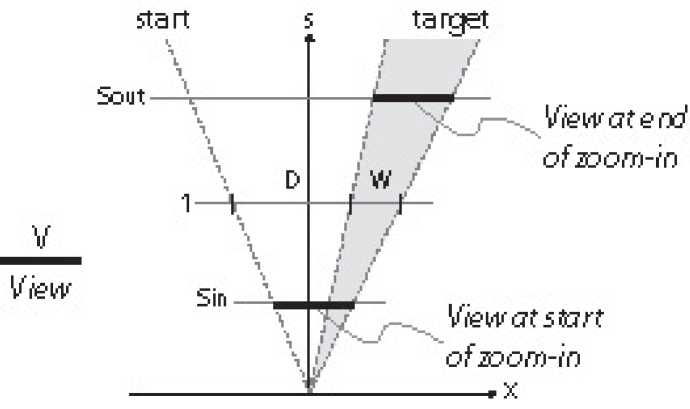17
zoom-index space, which is the only space where distances in scale can be computed, the
zoom-index distance (ZD) is log sout - log sin.

Figure 16. Multi-scale pointing towards a target. D and W are measured at scale 1. Sin and Sout correspond
to the start and end of the zoom-in phase.
ZD is computed using the scaling invariant (equation 3). We first compute sin and sout. At
scale sin, the view (size V) covers the distance D to the target, and the target itself (size W), so
we have:
(D + W) / 1 = V / sin or: sin = V / (D + W)
At scale sout, the view (size V) covers the target (size W) so we have:
W / 1 = V / sout or: sout = V / W
We now compute ZD:
ZD = log sout - log sin = log V/W - log V/(D+W) = log (D+W)/W = log (1 + D/W) = ID
Therefore the distance to navigate in zoom-index space is exactly the index of difficulty (ID)
of the task. Note that this is independent of view size V: indeed, a smaller view would require
starting at a lower scale, but the task would be completed at a lower scale as well.
4.2. From the Steering law to Fitts’ law
The view pointing task described above is reminiscent of a steering task (Accot & Zhai,
1997): from the moment the target is in the view, zooming-in is similar to driving a vehicle
through a tunnel. The driver uses the accelerator to proceed through the tunnel and turns the
wheel to correct any current aiming error. Here, the user zooms-in toward the target and pans
to correct any aiming error. If the target moves out of view (the user is off the road), the user
must zoom-out (back up) until the target gets back into view and then zoom-in again. For
successful navigation, the target must stay within the view while zooming-in proceeds, just as
the car must stay inside the tunnel while traversing it. Therefore we can use Accot and Zhai’s
(1997) steering law for tunnels to predict navigation time:
MT = k d / w
where d is the length of the tunnel and w its width. In our case, d is the distance navigated
along the scale dimension, which we have shown to be equal to the index of difficulty ID, and
w is the target size of the view, which we call V. Therefore we have:
MT = (k / V) ID (4)
More intriguing information
1. The name is absent2. The Role of Trait Emotional Intelligence (El) in the Workplace.
3. Multiple Arrhythmogenic Substrate for Tachycardia in a
4. Competition In or For the Field: Which is Better
5. Yield curve analysis
6. Großhandel: Steigende Umsätze und schwungvolle Investitionsdynamik
7. The name is absent
8. Performance - Complexity Comparison of Receivers for a LTE MIMO–OFDM System
9. The Tangible Contribution of R&D Spending Foreign-Owned Plants to a Host Region: a Plant Level Study of the Irish Manufacturing Sector (1980-1996)
10. Two-Part Tax Controls for Forest Density and Rotation Time